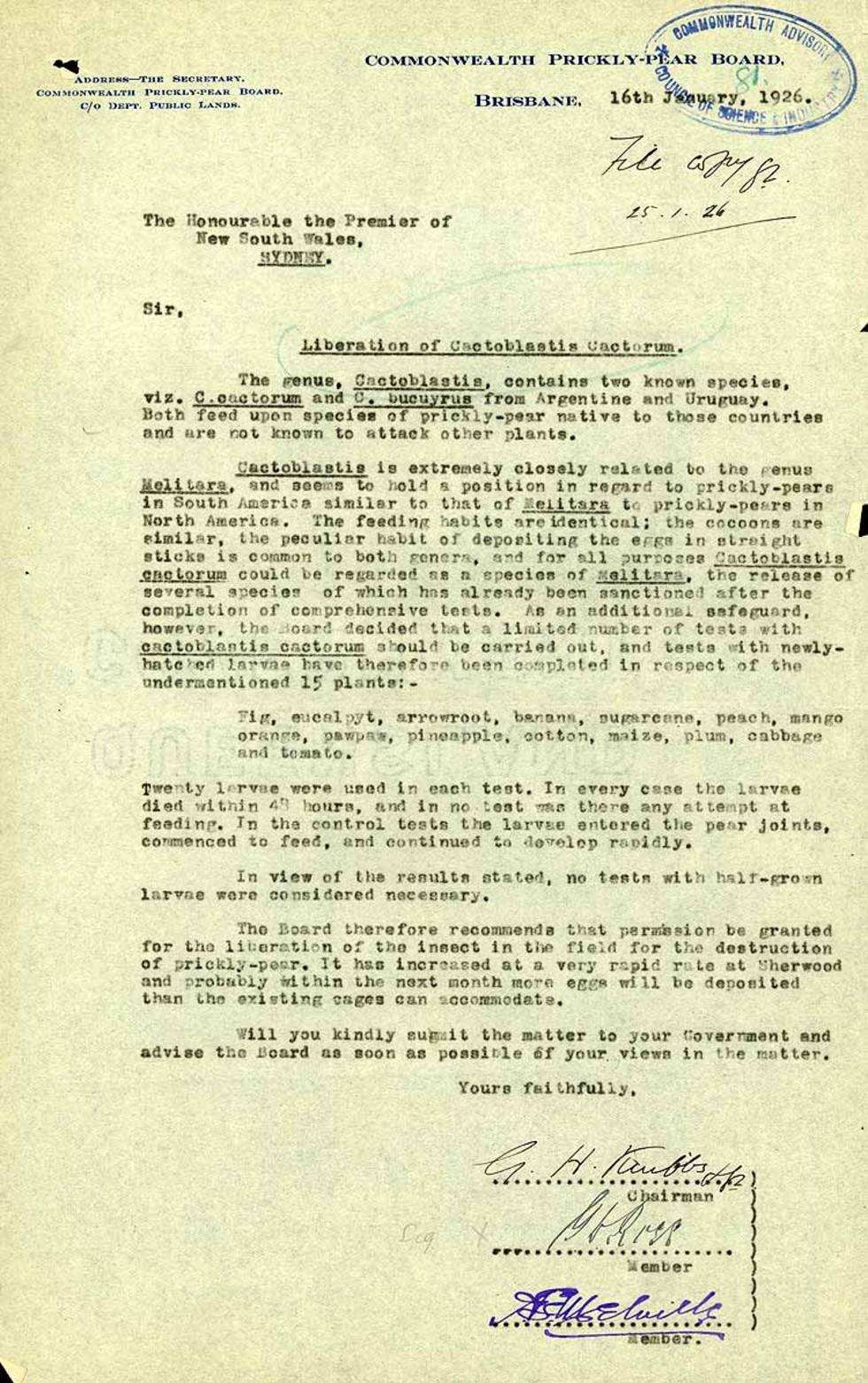
Request sent to Premier of New South Wales.
Aboriginal and Torres Strait Islander people should be aware that the National Archives' website and collection contain the names, images and voices of people who have died.
Some records include terms and views that are not appropriate today. They reflect the period in which they were created and are not the views of the National Archives.


Request sent to Premier of New South Wales.
[Letterhead in blue ink for the 'COMMONWEALTH PRICKLY-PEAR BOARD. BRISBANE.']
[Stamped in blue ink:] COMMONWEALTH ADVISORY COUNCIL OF SCIENCE & INDUSTRY
[Handwritten annotation in black ink:] File copy 82. 25.1.26
16th January, 1926.
The Honourable the Premier of New South Wales,
[Capitalised] SYDNEY.
Sir,
[Underlined] Liberation of Cactoblastis Cactorum.
The genus, Cactoblastis [underlined], contains two known species, viz. C. cactorum [underlined] and C. bucuyrus [underlined] from Argentine and Uruguay. Both feed upon species of prickly-pear native to those countries and are not known to attach other plants.
Cactoblastis [underlined] is extremely closely related to the genus Melitara [underlined], and seems to hold a position in regard to prickly-pears in South America similar to that of Melitara [underlined] to prickly-pears in North America. The feeding habits are identical; the cocoons are similar, the peculiar habit of depositing the eggs in straight sticks is common to both genera, and for all purposes Cactoblastis cactorum [underlined] could be regarded as a species of Melitara [underlined], the release of several species of which has already been asnctioned [sic] after the completion of comprehensive tests. As an additional safeguard, however, the Board decided that a limited number of tests with cactoblastis cactorum [underlined] should be carried out, and tests with newly-hatched larvae have therefore been completed in respect of the undermentioned 15 plants:-
Fig, eucalypt, arrowroot, banana, sugarcane, peach, mango orange [sic], pawpaw, pineapple, cotton, maize, plum, cabbage and tomato.
Twenty larvae were used in each test. In every case the larvae died within 48 hours, and in no test was there any attempt at feeding. In the control tests the larvae entered the pear joints, commenced to feed, and continued to develop rapidly.
In view of the results stated, no tests with half-grown larvae were considered necessary.
The Board therefore recommends that permission be granted for the liberation of the insect in the field for the destruction of prickly-pear. It has increased at a very rapid rate at Sherwood and probably within the next month more eggs will be deposited than the existing cages can accommodate.
Will you kindly submit the matter to your Government and advise the Board as soon as possible of your views in the matter.
Yours faithfully,
[Handwritten signature] G.H. Knibbs
Chairman
[Handwritten signature – illegible, possibly G.L. Board]
Member
[Handwritten signature] A.G. Melville
Member.
This is a request sent to the Premier of New South Wales regarding the eradication of the 'Prickly Pear' plant which had become a rapid spreading weed since its introduction the News South Wales and Queensland. The first prickly pear plants were introduced to Australia 1788.
Learn how to interpret primary sources, use our collection and more.
